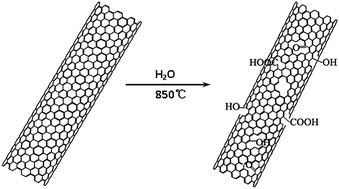Porous carbon nanotubes etched by water steam for high-rate large-capacity lithium–sulfur batteries†
Abstract
The current investigation of lithium–sulfur (Li–S) batteries faces three practical problems: (1) the poor conductivity of sulfur; (2) the notorious shuttle mechanism; and (3) the volume variation of the sulfur cathode. In principle, carbon nanotubes (CNTs) have a strong potential for improving sulfur usage because of their high electrical conductivity. Furthermore, opening holes in CNTs or creating pores on the walls is also a useful approach to not only enhance the diffusion of Li ions, but also enable more sulfur to fill the interior of the CNTs, which would be beneficial in retaining the soluble poly-sulfide intermediates and accommodate volume variations. Herein, we designed a mild one-step oxidation approach to create porous CNTs (PCNTs) through a chemical reaction between CNTs and rare oxygen sourced from a nebulized water stream at high temperatures. The higher specific surface area and pore volume values confirmed that PCNTs had significant porosity, compared with raw CNTs. When the PCNTs–S composites were tested as cathode materials in Li–S batteries, the cathode with 78 wt% S content exhibited an initial reversible capacity of 1382 mA h g−1 at 0.2 C. Furthermore, a reversible capacity of 150 mA h g−1 can be preserved, even at a very high current rate of 15 C. More importantly, it is also confirmed that a cathode with 89 wt% S content unexpectedly delivered a reversible capacity as high as 1165 mA h g−1sulfur/830 mA h g−1electrode at the initial cycle, and 792 mA h g−1sulfur/564 mA h g−1electrode after 200 cycles at a current rate of 0.2 C. To the best of our knowledge, such a high rate performance (15 C) and S loading (89 wt%) in cathodes of advanced Li–S batteries have been infrequently reported in previous research.


 Please wait while we load your content...
Please wait while we load your content...